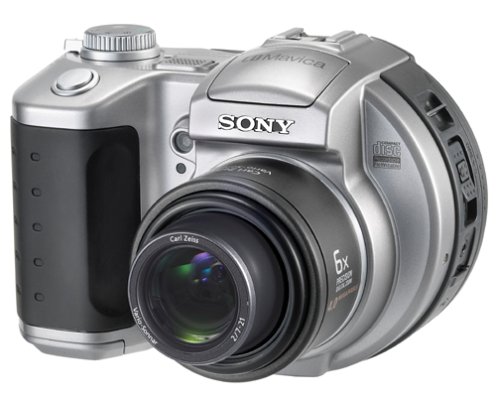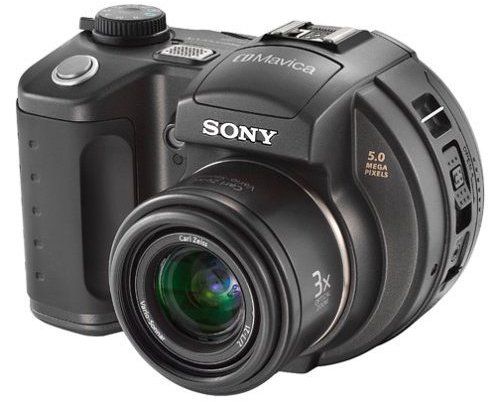The unique feature of Sony's CD400 Mavica is a built-in mini-CD
recorder, a clever solution that simultaneously provides affordable portable memory and
long-term archival storage. The camera also features a 4-megapixel sensor, a 3x optical
zoom Carl Zeiss lens, a jumbo 2.5-inch display, and long-life rechargeable lithium-ion
battery. Optics and Resolution
The CD400's 4-megapixel sensor captures a tremendous amount of detail, allowing sharp
11-by-14-inch prints with pixels to spare. If you're currently using a high-quality 35mm
point-and-shoot, expect to see as much detail in your digital pictures as you currently
see in your film photos.
A 3x Carl Zeiss optical zoom lens (34-102mm equivalent)
helps you to capture exactly the picture you want, and an additional 2x digital zoom (6x
total) further magnifies your image. Remember, however, that digital zoom tends to reduce
the sharpness and detail of your image, so it's best used sparingly. In low-light
situations (a particular weakness for many digital cameras), a focus-assist lamp sends out
a small patterned beam to help the camera accurately determine distance.
To save space, there's no traditional optical viewfinder
to look through. Instead, to compose your images or review shots you've already taken, the
CD400 uses a 2.5-inch color display. The advantage to using the LCD to frame your shots is
that the screen lets you see exactly the picture you'll capture. The disadvantage is that
you can't turn off the screen and just use the optical viewfinder to extend battery life.
Fortunately, the included rechargeable battery holds a relatively good charge.
More Features
The engineers at Sony have gone out of their way to make it as easy as possible to share
your images online. For example, the e-mail mode stores a lower-resolution version of your
picture on the disc in a separate folder from the full-size version. This compact file
lacks the detail of the original, but has a small file size, making it ideal for e-mail
attachments. In addition, a video e-mail mode captures highly compressed, less-detailed
movie clips that are also small enough to easily e-mail. With the time, expertise, and the
right software, owners of any digital camera can create these more compact files on their
home computers, but Sony saves you this trouble.
More advanced photographers will appreciate manual focus,
a 14-bit A/D processor that captures more gradations in color than most digital cameras,
and an uncompressed TIFF mode for recording the highest-quality photos.
Power
The CD400 uses Sony's excellent InfoLithium battery system, which not only holds a
respectable charge, but also displays on screen how many minutes of power remain. Both the
battery and the charger are included. Because the battery is unique to specific Sony
models and can be nearly impossible to find when on the road, we strongly recommend
getting a spare if you're planning to take the camera on extended outings.
Movie Mode
In movie mode, the camera captures video clips with sound at resolutions up to 320 x 240
pixels. Unlike most digital cameras, the length of each video is limited only by the
amount of memory left on the CD. The limited resolution of these clips guarantees that
this feature won't replace your camcorder, but it's perfect for when you just want to
capture a quick movie and e-mail it to a friend or relative.
Storage and Transfer
With a traditional digital camera, images are stored on memory cards, then transferred to
your computer via a cable or card reader, and ultimately archived by recording on a CD-R
or other high-capacity medium. Sony's CD Mavicas simplify this process by recording images
directly to CD, using a 3-inch miniature CD recorder integrated into the back of the
camera (hence the camera's rounded shape). These discs are substantially smaller than
traditional 5-inch CDs, and only hold about one-fourth as much information (156 MB instead
of 650 MB), but this is still enough space to store over 60 photos at the camera's
highest-quality compressed mode. Note: It is possible and even recommended to use
the higher-capacity 256 MB Pocket CD-R's that are widely available! Singly, each
disc costs a couple of dollars. To transfer pictures to your computer, simply remove the
disc from the camera and insert it into your computer's CD-ROM drive. Unlike images
recorded on memory cards, pictures taken on a CD-R are permanently burned into the disc,
instantly providing a digital "negative" for archiving your photos.
If you prefer to transfer your images in the traditional
way, just use an erasable/re-recordable CD-RW disc and connect the camera to your computer
with the included USB cable. After transferring the images, you can erase the CD-RW disc
to ready it for another batch of photos.
Size
At 5.5 by 3.75 by 4 inches, and 23 ounces, you won't slip this one into your shirt pocket,
but it's still one of the smallest disc-based cameras available. The CD400 fits nicely
into most SLR camera carrying cases.
Contents and Recommended Accessories
The package includes the CD400 camera, NP-FM50 battery, AC-L10 cable for in-camera
charging, six 3-inch CD-R discs, one 3-inch re-recordable CD-RW, shoulder strap, AV cable,
USB cable, and software on CD.
Everything you need to get started is included in the
box, but we recommend these accessories to make the most of your camera: a carrying case,
additional 3-inch CD-R or CD-RW discs, and a second battery (especially if you're taking
the camera on extended trips). Compatible accessories for this camera are listed near the
top of this page. --Shane Burnett
Pros:
- Integrated CD recorder provides inexpensive storage and
image archiving
- Big 2.5-inch screen makes it easy to preview and review
photos
- E-mail modes make it easy to share your photos
electronically
Cons:
- No traditional optical viewfinder
- CD drive makes the camera bigger and heavier than cameras
using memory cards


Visitors since 2/25/04